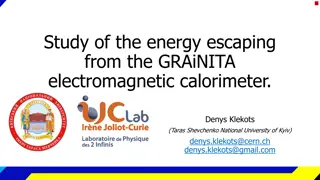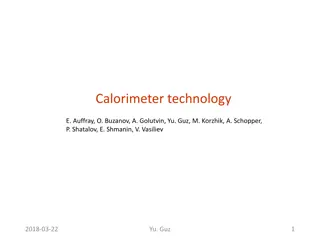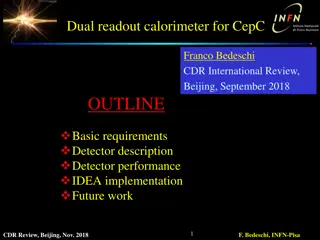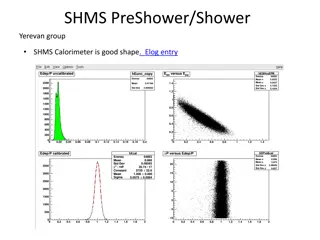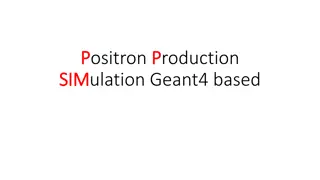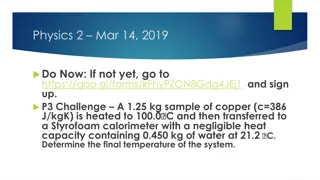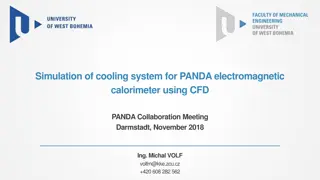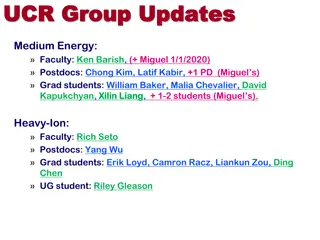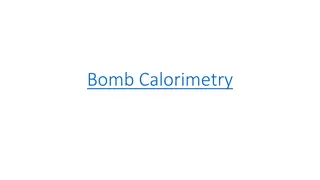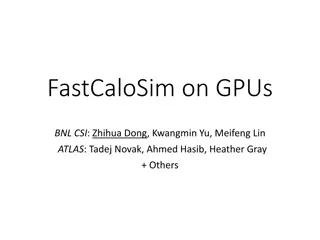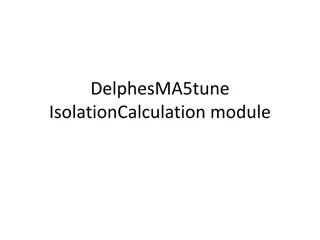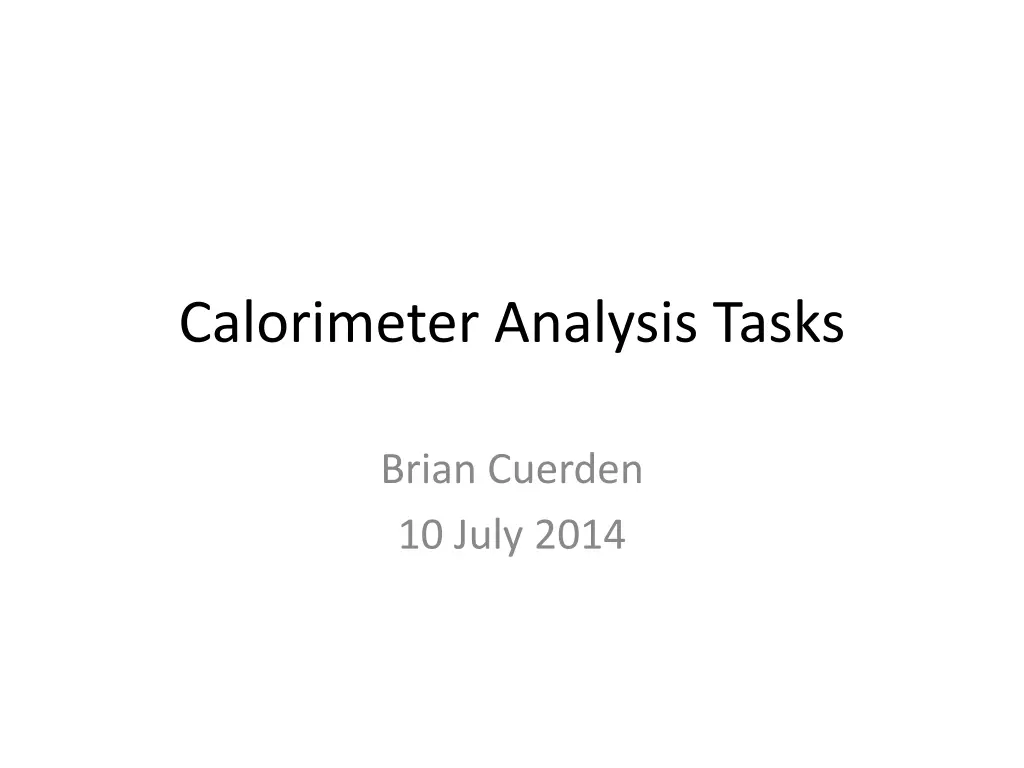
Calorimeter Analysis Tasks and Model Comparisons
Explore a comprehensive analysis of calorimeter models, including time constant checks, temperature comparisons, and shell convection coefficients. Gain insights into the simple model's response, gradients, and the Mini-F-Cal model's dimensions. Understand the external boundary conditions of the test bed and the convection factors affecting the calorimeter's performance.
Download Presentation

Please find below an Image/Link to download the presentation.
The content on the website is provided AS IS for your information and personal use only. It may not be sold, licensed, or shared on other websites without obtaining consent from the author. If you encounter any issues during the download, it is possible that the publisher has removed the file from their server.
You are allowed to download the files provided on this website for personal or commercial use, subject to the condition that they are used lawfully. All files are the property of their respective owners.
The content on the website is provided AS IS for your information and personal use only. It may not be sold, licensed, or shared on other websites without obtaining consent from the author.
E N D
Presentation Transcript
Calorimeter Analysis Tasks Brian Cuerden 10 July 2014
Calorimeter Time Constant Check A simple model consisting of a mass with associated convective area was used for a time constant check. The mass and the convective surface are at the same temperature which increases over time due to applied heat. Model parameters are listed below. Simple Model Mass = Heat capacity = Convective area = Conv coef = Heat load = 6,213 1.35E+ 06 1.96E+ 06 3.83E-05 20.71 kg (half model) J/K mm^ 2 (1/2 model) W/mm^ 2-K W (half model)
Simple model compared to calorimeter results Temperature After Step Application of Power 90.6 90.5 90.4 T2481 Temp, Deg K 90.3 T2489 T2495 90.2 T2406 90.1 T2500 90 Simple model Steady state results are shown above. High temperatures occur in a fraction of the total volume in the heated region and away from the cooled region. 89.9 0 20,000 40,000 60,000 80,000 100,000 Time, seconds Simple model results are representative of the lower temperature nodes that were selected for the response plot. The gradients (in the detailed model) developed in 40,000 seconds after which the mass heated at a uniform rate. The time constant for gradient development (time to 63.2% of the steady state value) is 15,300 sec or 4.25 hrs.
Simple Model with Various Shell Convection Coefficients Simple Model Temperature After Step Application of Power Simple Model Temperature After Step Application of Power 90.5 91.8 H=38.3 W/m^2-K 0.5*H nom 2*H nm H=0 91.6 90.4 91.4 90.3 Temp, Deg K 91.2 Temp, Deg K 91.0 90.2 90.8 H=38.3 W/m^2-K 0.5*H nom 2*H nm H=0 90.6 90.1 90.4 90.2 90.0 90.0 89.8 89.9 0 20,000 40,000 60,000 80,000 100,000 0 20,000 40,000 60,000 80,000 100,000 Time, seconds Time, seconds The time constant of the simple model response is taken to be the time for 63.2% of the mass temperature change. at 50% of the nominal convective coefficient the time constant is 9.86 hours at 100% of the nominal convective coefficient the time constant is 4.58 hours at 200% of the nominal convective coefficient the time constant is 2.50 hours
Length of Mini-F-Cal The mini-F-Cal model was based on the dimensions tab of the Excel file Heatmini.xlsx as shown below. The specified and modeled length of the calorimeter is 30 cm as was intended.
Test Bed External Boundary Conditions Initially the six sides of the test bed box were constrained to be at 90 K Based on the gap convection results, external convection could be as low as 49 W/m2- K Free convection in the 12 mm gap on the 900 mm diameter calorimeter was 38 W/m2- K for an 0.5 K differential and 49 W/m2- K for a 2 K differential On the 144 mm diameter ID with a gap of 14 mm convection was calculated to be 40 W/m2- K for an 0.15 K differential Because the fluid is less constrained around the test bed as compared to the gap cases, the free convection coefficient is expected to be larger than the above cited gap values and 49 W/m2- K is taken as a minimum value. Conduction through the G10 on five sides is equivalent to 20 W/m2- K (20 to 23.4 mm of G10). Adding convection to this gives 14 W/m2- K or ~70% of the conduction expected if convection to the Argon pool is high. Conduction through the copper matrix is high so the addition of convection to the Argon pool makes a large difference. It is concluded that external convection cannot be neglected. Additional cases with external convection of 49 W/m2- K and 98 W/m2- K have been added to these results.
Summary of Test Bed Analysis Results The conduction across the argon layer will be determined by measuring the heat flux through the G10 layer and the temperature drop across the argon layer. Heat flux and temperature drop will be measured near the centerline. Test Bed Transient Response, 0.5deg Gradient Time required for stability: 0.5 The heat flux through the G10 will be calculated from the gradient through the G10. The ratio of the G10 and argon gradients is stable after 0.4 hours for both nominal (low) and high external convection cases. 0.5 Argon to G10 gradient ratio 0.4 0.4 0.3 High H 0.5K 0.3 High H 2 K 0.2 Nom H 0.5 K 0.2 Nom H 2 K 0.1 0.1 0.0 0.0 0.2 0.4 0.6 0.8 1.0 time, hours
Temperature of the Argon Layer The argon layer temperature and the copper matrix temperature are sensitive to the external convection coefficient. It should be possible to determine the external convection coefficient from the test data. Boiling in the argon layer must be avoided. Test Bed Transient Response, Argon Layer Temperature on the G10 side 94.0 93.5 Argon to G10 gradient ratio 93.0 92.5 High H 0.5K 92.0 High H 2 K 91.5 Nom H 0.5 K 91.0 Nom H 2 K 90.5 90.0 0.0 0.2 0.4 0.6 0.8 1.0 time, hours If the external convection coefficient is low the argon layer temperature will be higher and boiling may occur. This will increase the heat transfer rate since nucleate boiling is a particularly effective heat transfer mechanism.
Mini-F-Cal with Conductive Bars Contact conductance between the bar and the 12 mm OD pipe is estimated to be larger than or equal to an argon film 0.1 mm thick Q/ T = 2.2 W/ K Argon conductivity is 0.1315E-3 W/mm/K Area in contact is 12 *44 mm2 Path length is 0.1 mm For reference the conduction from the matrix to the tube through the 3x44mm strap is 12.4 W/ K Copper conductivity is 0.542 Area is 3x44=132 mm2 Path length is ~ 30 mm (20 mm to the tube and the distance around the tube Contact resistance is modeled by decreasing the conductivity of part of the copper bar near the tube . The tube is a region constrained to 77 K
Nominal Power Level, Cooled only by the LN2 loop Most of the collimator is near 84 K. The bar could be shortened since most of its length is at the same temperature as the copper matrix. The only cooling here is from the LN2 loop.
Operation at 7.5 times Power The LN2 loop is still at 77 K but 7.5 times the power is applied resulting in a peak temperature of 132 K. Again the only cooling is from the LN2 loop.
Operation at 7.5xPower with LN2 Loop Cooling and External Wall Cooling by 90 K Argon Peak temp is 101 K
Backup Slides Test bed results with various outer surface convection coefficients
Thermal Result for an 0.5K Gradient Across the 12 mm Argon Layer, Net Conductance of the Argon is 3.8 Times the Conductivity of Argon Node Temp deg K 91.56 Del T deg K Q center W/m^ 2 4570 Mid Insul 1.05 26.14 4620 90.51 Aluminum 0 4670 90.51 Argon 0.5 21.13 4720 90.01 Copper Total heat input = Heat into 8 mm Al plate = Heat into 12 mm Argon layer = 1.77 W (21.9 W/m2) Heat out of Argon Layer = 1.67 W Radial loss from Al and Argon 0.14 W Heat lost through base = 6.75 W 1.82 W Outer surfaces fixed at 90 K (very high convection coefficient) 4.84 W 72% of the input heat is lost through the base. Most of the rest passes through the Argon 14
Thermal Result for a 2K Gradient Across the 12 mm Argon Layer, Net Conductance of the Argon is 4.8 Times the Conductivity of Argon Node Temp deg K 97.083 Del T deg K Q center W/m^ 2 4570 Mid Insul 5.045 125.36 4620 92.038 Aluminum 0.009 105.2 4670 92.029 Argon 2.002 105.28 4720 90.027 Copper Total heat input = Heat into 8 mm Al plate = Heat into 12 mm Argon layer = 8.62 W (107 W/m2) Heat out of Argon Layer = 8.26 W Radial loss from Al and Argon 0.49 W Heat lost through base = 31.18 W 8.78 W Outer surfaces fixed at 90 K (very high convection coefficient) 22.04 W 70% of the input heat is lost through the base. Most of the rest passes through the Argon 15
Thermal Result for an 0.5K Gradient Across the 12 mm Argon Layer, Net Conductance of the Argon is 3.8 Times the Conductivity of Argon Node Temp deg K 92.07 Del T deg K Q center W/m^ 2 4570 Mid Insul 1.25 28.48 4620 90.82 Aluminum -0.1 4670 90.92 Argon 0.5 21.16 4720 90.42 Copper Total heat input = Heat into 8 mm Al plate = Heat into 12 mm Argon layer = 1.90 W (23.6 W/m2) Heat out of Argon Layer = 1.72 W Radial loss from Al and Argon 0.32 W Heat lost through base = 6.05 W 2.00 W Outer surface convection to 90K is 49 W/m2- K (nominal convection coefficient) 4.05 W 67% of the input heat is lost through the base. Most of the rest passes through the Argon 16
Thermal Result for a 2K Gradient Across the 12 mm Argon Layer, Net Conductance of the Argon is 4.8 Times the Conductivity of Argon Node Temp deg K 99.66 Del T deg K Q center W/m^ 2 4570 Mid Insul 5.58 138.2 4620 94.08 Aluminum 0.01 4670 94.07 Argon 2 105.2 4720 92.07 Total heat input = Heat into 8 mm Al plate = Heat into 12 mm Argon layer = 9.35 W (116 W/m2) Heat out of Argon Layer = 8.53 W Radial loss from Al and Argon 1.41 W Heat lost through base = 28.62 W 9.72 W Outer surface convection to 90K is 49 W/m2- K (nominal convection coefficient) 18.90 W 66% of the input heat is lost through the base. Most of the rest passes through the Argon 17
A tabular summary of test bed results with various external convection values and with 0.5 and 2 K gradients in the Argon layer tp5 High t2 tp5Hnom t2Hnom nominal tp5H2x 2*nom t2H2x 2*nom External convection High nominal T4570 T4620 (4570-4620 = G10) T4670 (4620-4670 = Al) T4720 (4670-4720 = Argon) T4770 (4720-4770 = copper) deg K deg K deg K deg K deg K 91.56 90.51 90.51 90.01 90.01 97.07 92.04 92.03 90.03 90.03 92.07 90.82 90.92 90.42 90.42 99.66 94.08 94.07 92.07 92.07 92.07 90.92 90.92 90.42 90.42 99.66 94.07 94.07 92.07 92.07 Reduced external convection results in a significant increase in the copper matrix and Argon layer) temperatures. Q4620 Mid insulation Q4670 Aluminum Q4720 Argon layer W W W 0.0033 0.0026 0.0026 0.0157 0.0132 0.0132 0.0036 0.0026 0.0026 0.0173 0.0131 0.0131 0.0035 0.0026 0.0026 0.0173 0.0132 0.0131 Total heat input Heat into 8mm Al plate Heat into Argon layer Heat out of Argon layer Radial loss from Al and Argon Lost through base W W W W W W 6.750 1.823 1.767 1.672 0.142 4.840 31.180 8.780 8.620 8.260 0.490 22.040 6.049 1.997 1.901 1.719 0.319 4.052 28.622 9.719 9.350 8.527 1.412 18.903 6.031 1.991 1.895 1.714 0.318 4.040 28.630 9.721 9.352 8.529 1.413 18.908 Reduced external convection changes the ratio of Argon layer to G10 layer heat flux from 81-84% for high coupling to 74-76% for low coupling efficiency. Derived results Qcenter across G10 Qcenter across Argon Qargon/QG10 = W/m^ 2 W/m^ 2 26.14 21.13 81% 125.36 105.20 84% 28.48 21.16 74% 138.18 105.18 76% 28.40 21.10 74% 138.22 105.20 76% Qaverage across argon W/m^ 2 21.93 106.98 23.59 116.04 23.52 116.07
Temperature Drop Across the Argon Layer Test Bed Transient Response, Temperature Drop Across the Argon Layer 2.5 2.0 1.5 High H 0.5K deg K High H 2 K 1.0 Nom H 0.5 K Nom H 2 K 0.5 0.0 0.0 0.2 0.4 0.6 0.8 1.0 time, hours 19



